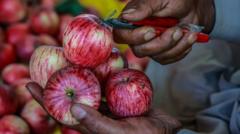

Indian scientists are on a quest to cultivate the perfect apple, one that can thrive in the country's diverse climate and appeal to local tastes. This pursuit is driven by a growing demand for apples in India, which has led to a significant increase in imports.
India's apple production has risen by 15% over the last five years, reaching 2.5 million tonnes. However, this increase has not kept pace with the escalating demand, causing imports to double to approximately 600,000 tonnes during the same period. S Chandrashekhar, an analyst of India's apple trade, points out that this shortage is exacerbated by a lack of new investment and new participants in the apple cultivation sector.
A critical factor for successful apple cultivation is a prolonged period of winter temperatures between 0°C and 6°C. Regions like the UK, which experience around 1,000 hours of such "chill-time," can cultivate almost any apple variety. However, in India, areas with these conditions are limited, with most of the apple production concentrated in Jammu and Kashmir and Himachal Pradesh. These traditional apple-growing regions are facing declining productivity due to old orchards and the impact of climate change, which is reducing the number of crucial chilling hours and causing erratic weather patterns that lead to financial losses for farmers.
To address these challenges, scientists and farmers are experimenting with "low-chill" apple varieties that require only about 400 hours of temperatures between 0°C and 6°C. In Ranchi, eastern India, researchers at Birsa Agricultural University (BAU) are testing 18 saplings of three low-chill varieties. Although only one variety has produced fruit so far, Dr. Majid Ali notes that the plants have not yet reached optimal sizes, yielding only one to two kilograms of apples in 2024. He acknowledges that the quality is not the best, and the local soil and climate pose additional challenges, such as termite attacks.
Scientists at the Sher-e-Kashmir University of Agricultural Sciences and Technology are experimenting with 300 apple varieties to assess the impact of climate change and identify climate-resilient apple genotypes. Dr. Thakur's team has developed an apple variety that matures two months earlier than existing ones, which helps offset erratic weather patterns and provides a quality advantage in areas with insufficient sunlight for color formation. He emphasizes that this is just the beginning of research aimed at creating climate-resilient fruits that appeal to the Indian palate.
In addition to these efforts, the National Innovation Foundation-India has been supporting the dissemination of the HRMN-99 apple variety, which can be grown in tropical and subtropical areas with temperatures as high as 40 to 45°C. This variety does not require deep chilling hours for flowering and fruit setting and has shown promising results in multiple states.
While scientific advancements are crucial, boosting India's apple output requires more than just research. According to Mr. Chandrashekhar, many apple orchards in traditional cultivation areas are 15 to 20 years old and need rejuvenation.
Ultimately, the quest for the perfect apple in India is a multifaceted challenge that requires innovative scientific research, climate-resilient varieties, and sustainable farming practices to meet the country's growing demand and ensure a stable and productive apple industry.